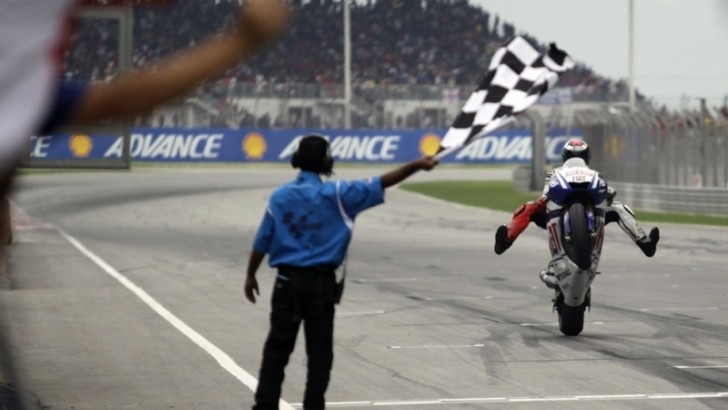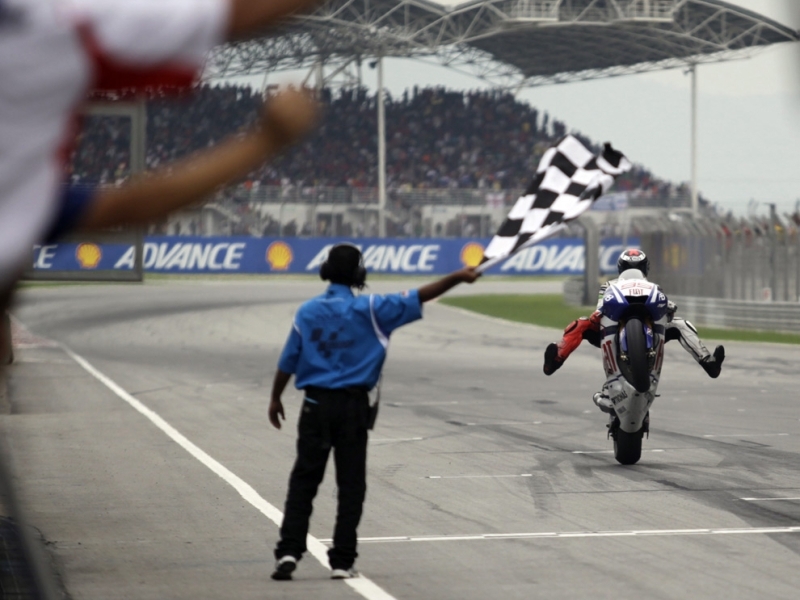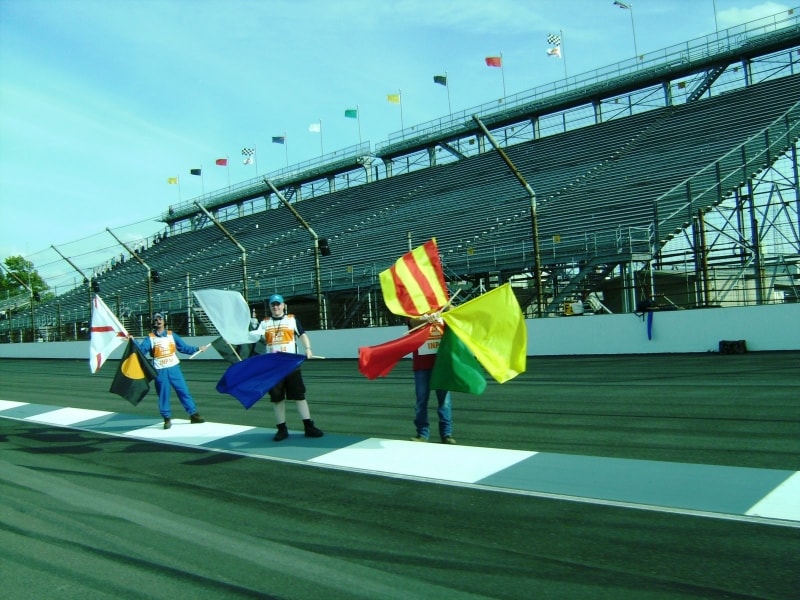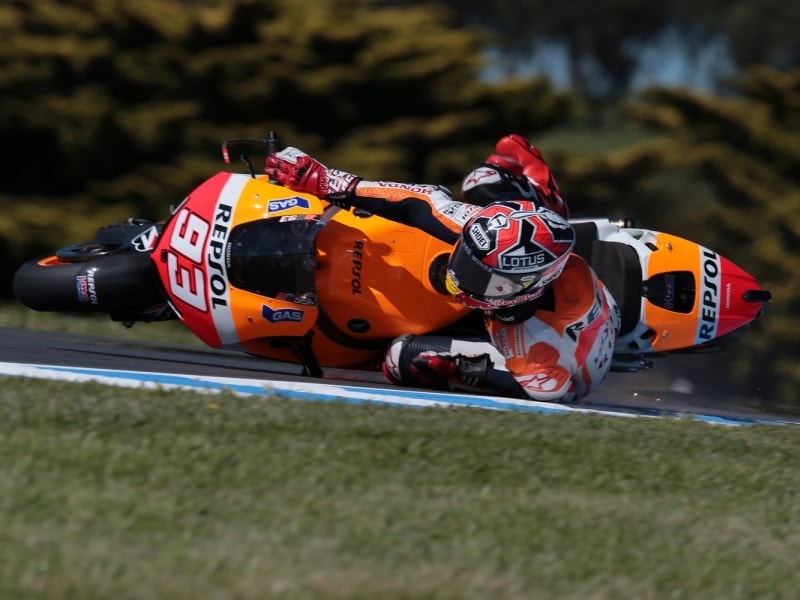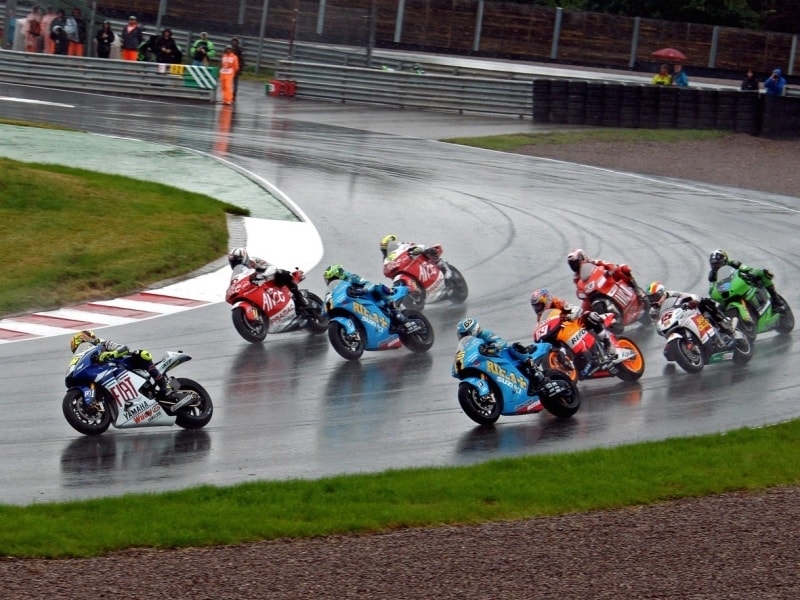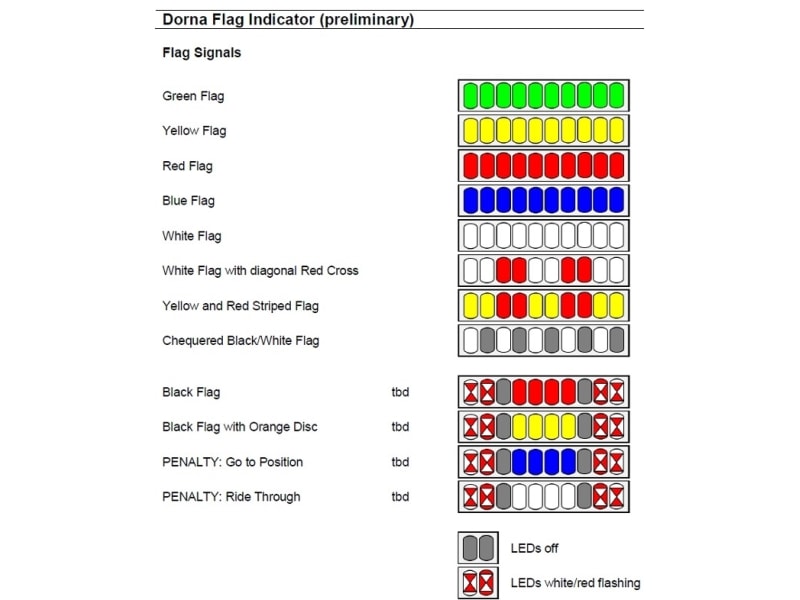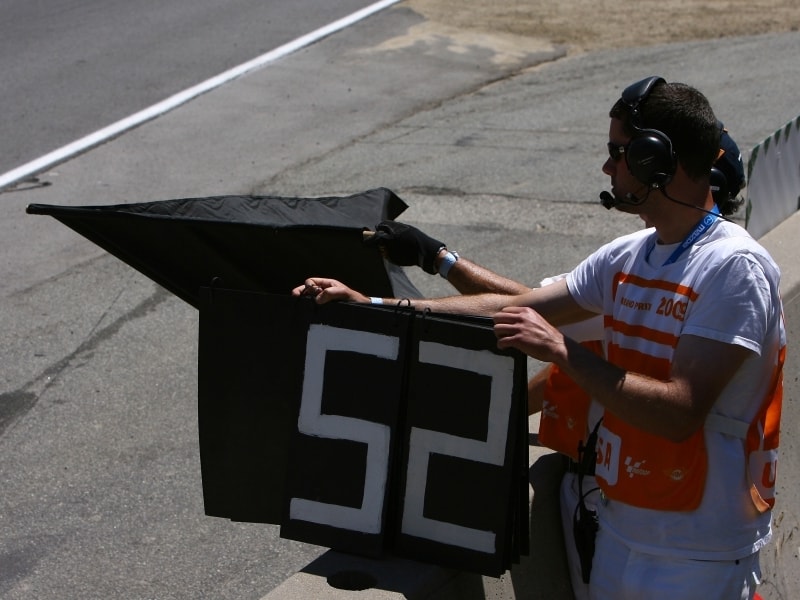The fact that Dorna Sports is bent on adding as much more competitiveness to the MotoGP series is no secret, and it's been years since the rights holder for the championship has gradually implemented more regulations aimed at making the show better.
Aside from the mandatory ECU each team must use on their bikes starting 2014 and the rumored spec software that may cause Honda Racing Corporation (HRC) to retire form MotoGP, Dorna is looking for ways to make everything more precise, and this includes timing and communication between Race Direction and the bikes.
MotoGP racing is a battle in which thousandths of a second can make the difference between a world champion and the runner-up, let alone hundredths or tenths. In fact, when we have to deal with gaps measured in tenths of a second, we're already talking about who's NOT going to win the race.
Precise timing is a key element of the whole series from at least two points of view. First of all, we're talking about timing the riders and establishing the final results, but this is utterly obvious.
The second purpose of precise timing is paramount for the whole series: intermediate timing offers a very good picture of a racer and his bike's progress. Most MotoGP circuits have three intermediate clocking points and teams use these results to understand better the particularities of a track.
The story goes much further, as these timing results are crucial in bike setup and will affect the bike's geometry, suspension settings, choice of tires, engine mapping and all.
Racers are timed using a very simple method of radio communication. The bike has a special radio emitter module, which identifies the machine as it passes above one of the "loops" in the track.
A radio signal coming from the bike is picked up by these antennae and since radio waves travel almost instantaneously, the information is delivered extremely fast. The impulse is then passed to a precise timing computer and the timing results can then be displayed to all interested in real time and with extreme precision.
However, this part of MotoGP is also about to change, as Dorna is set to enforce another technological change: two-way communication between the bike and Race Direction. Unlike in Formula 1, teams can only communicate with the riders by means of the sheets displayed in the home straight.
The boards convey only basic info, such as the gaps to the rider in the front and the one behind, whether a rival crashed or was blackflagged, the open pit, sanctions or so. In addition to these boards, the marshals can also use specific flags to inform a rider or a group of riders on racing changes, such as rain, crashes ahead, disqualifying and the like.
For example, Honda's Marc Marquez saw a black flag at Phillip Island last autumn, for failing to enter the pit in due time for the mandatory 10-lap tire change.
Now, the changes Dorna is looking forward to make in this aspect will not bring any sort of telemetry and communication between the pit and the rider. Instead, the new comm module, manufactured by the German company 2D, will be able to also receive data sent by the Race Commission.
Namely, the new communication module will also provide the rider with flag data (list of MotoGP flags and their meaning after the jump).The cool thing is that this info is intended to be conveyed to the riders faster than it is now passed by the marshals' flags.
This in turn, requires more antennae and it's possible to see Dorna looking to ask the MotoGP circuits to upgrade to a turn-by-turn communication grid. Such a solution makes sure that the necessary info is passed immediately to all those who need to learn about it, regardless of their position on the track.
Circuits which are also used for Formula 1 racing (Catalunya, CotA, Silverstone) already have more “loops,” and in case the changes become mandatory, the others will have to upgrade, too.
We have to admit that alerts on emergency situations and on-track hazards are best conveyed as quickly as possible. This includes the red or the yellow flags, signaling a stopped race or danger and passing interdiction for safety reasons.
The bi-directional communication module is linked to a special-purpose array of colored warning LED lights. The module receives a message and the panel will light the needed light accordingly, providing the rider with direct, easily-readable flag info.
This system can also inform pilots about penalty decisions the Race Direction might make during a race or practice session, such as “Go to position” or “Ride Through,” contributing to a more fluid racing environment.
For the moment, there's no further info on whether the bi-directional communication modules will become mandatory in 2014, but it looks like Casey Stoner already tested one for Honda, as gp-inside reports.
The meanings of the various flags used in MotoGP are below, as described by the official online outlet of the series, motogp.com.
Any Infringement of this rule during a practice session will result in the cancellation of the time of the lap during which the infraction occurred. In case of infringement of this rule during the race, the rider must go back the number of positions decided by the Race Direction.
During the final inspection lap, this flag must be waved at the exact place where the flag marshal will be positioned during the practices, warm-ups and races.
At the end of each practice session and warm-up, a red light will be switched on at the finish line.
This flag must also be shown motionless at the flag marshal post immediately after the incident that necessitated the use of one or more yellow flags.
MotoGP racing is a battle in which thousandths of a second can make the difference between a world champion and the runner-up, let alone hundredths or tenths. In fact, when we have to deal with gaps measured in tenths of a second, we're already talking about who's NOT going to win the race.
Precise timing is a key element of the whole series from at least two points of view. First of all, we're talking about timing the riders and establishing the final results, but this is utterly obvious.
The second purpose of precise timing is paramount for the whole series: intermediate timing offers a very good picture of a racer and his bike's progress. Most MotoGP circuits have three intermediate clocking points and teams use these results to understand better the particularities of a track.
The story goes much further, as these timing results are crucial in bike setup and will affect the bike's geometry, suspension settings, choice of tires, engine mapping and all.
Racers are timed using a very simple method of radio communication. The bike has a special radio emitter module, which identifies the machine as it passes above one of the "loops" in the track.
A radio signal coming from the bike is picked up by these antennae and since radio waves travel almost instantaneously, the information is delivered extremely fast. The impulse is then passed to a precise timing computer and the timing results can then be displayed to all interested in real time and with extreme precision.
However, this part of MotoGP is also about to change, as Dorna is set to enforce another technological change: two-way communication between the bike and Race Direction. Unlike in Formula 1, teams can only communicate with the riders by means of the sheets displayed in the home straight.
The boards convey only basic info, such as the gaps to the rider in the front and the one behind, whether a rival crashed or was blackflagged, the open pit, sanctions or so. In addition to these boards, the marshals can also use specific flags to inform a rider or a group of riders on racing changes, such as rain, crashes ahead, disqualifying and the like.
For example, Honda's Marc Marquez saw a black flag at Phillip Island last autumn, for failing to enter the pit in due time for the mandatory 10-lap tire change.
Now, the changes Dorna is looking forward to make in this aspect will not bring any sort of telemetry and communication between the pit and the rider. Instead, the new comm module, manufactured by the German company 2D, will be able to also receive data sent by the Race Commission.
Namely, the new communication module will also provide the rider with flag data (list of MotoGP flags and their meaning after the jump).The cool thing is that this info is intended to be conveyed to the riders faster than it is now passed by the marshals' flags.
This in turn, requires more antennae and it's possible to see Dorna looking to ask the MotoGP circuits to upgrade to a turn-by-turn communication grid. Such a solution makes sure that the necessary info is passed immediately to all those who need to learn about it, regardless of their position on the track.
Circuits which are also used for Formula 1 racing (Catalunya, CotA, Silverstone) already have more “loops,” and in case the changes become mandatory, the others will have to upgrade, too.
We have to admit that alerts on emergency situations and on-track hazards are best conveyed as quickly as possible. This includes the red or the yellow flags, signaling a stopped race or danger and passing interdiction for safety reasons.
The bi-directional communication module is linked to a special-purpose array of colored warning LED lights. The module receives a message and the panel will light the needed light accordingly, providing the rider with direct, easily-readable flag info.
This system can also inform pilots about penalty decisions the Race Direction might make during a race or practice session, such as “Go to position” or “Ride Through,” contributing to a more fluid racing environment.
For the moment, there's no further info on whether the bi-directional communication modules will become mandatory in 2014, but it looks like Casey Stoner already tested one for Honda, as gp-inside reports.
The meanings of the various flags used in MotoGP are below, as described by the official online outlet of the series, motogp.com.
Black Flag
Disqualification. Displayed motionless at each flag marshal post together with the rider's number, the black flag means the rider must stop at the pits at the end of the current lap and cannot restart. This flag will be presented only after the rider's team has been notified.Black Flag with Orange Disc
This flag informs the rider that his motorcycle has mechanical problems, which are likely to endanger himself or others, and that he must immediately leave the track.White Flag
Waved at the flag marshal post during the race, this flag indicates that the riders are allowed to change machine. The Race Direction indicates through the white flag that the track is wet enough to justify the change of bikes and the Grand Prix becomes a wet race, having originally been declared a ‘dry race’ at the start. See the Key Rules section for details of instances of the enforcing of this rule.White Flag with diagonal Red Cross and Yellow & Red Striped Flag
Rain on this section of the track (shown together, motionless at the flag marshal post) - this combination of flags simply advises the rider that the track is wet.Blue Flag
Shown waved at the flag marshal post, this flag indicates to a rider that he is about to be overtaken and he must allow the rider(s) following him to pass him at the earliest opportunity. During the practice sessions, the rider concerned must keep his line and slow down gradually to allow the faster rider to pass him. During the race, the rider concerned is about to be lapped. Also, this flag is shown to a rider leaving the pit lane if traffic is approaching on the track.Chequered Black & White Flag
This flag should be waved at the finish line on track level to indicate the finish of race or practice session. The race winner is the first rider to see this flag as he crosses the line.Yellow Flag
Shown waved at each row of the starting grid, this flag indicates that the start of the race is delayed. Shown waved at the flag marshal post, this flag indicates that there is a danger ahead. The riders must slow down and be prepared to stop. Overtaking is forbidden up until the point where the green flag is shown.Any Infringement of this rule during a practice session will result in the cancellation of the time of the lap during which the infraction occurred. In case of infringement of this rule during the race, the rider must go back the number of positions decided by the Race Direction.
During the final inspection lap, this flag must be waved at the exact place where the flag marshal will be positioned during the practices, warm-ups and races.
Red Flag and Red Lights
When the race or practice is being interrupted, the red flag will be waved at each flag marshal post and the red lights around the track will be switched on. Riders must return slowly to the pits. When the pit-lane exit is closed, this flag will be shown motionless at the pit-lane exit and the light will be switched on. Riders are not allowed to exit the pit lane.Red Lights
Race Start. The red lights will be switched on at the start line for between 2 and 5 seconds to start each race. ‘The lights go out’ is therefore a favourite phrase for commentators to indicate that a race has started.At the end of each practice session and warm-up, a red light will be switched on at the finish line.
Green Light
This light must be switched on at the pit lane exit to signal the start of each practice session and of the warm-up, the start of the sighting laps and of the warm up lap.Green Flag
The track is clear. This flag must be shown motionless at each flag marshal post for the first lap of each practice session and of the warm up, for the sighting lap(s) and for the warm up lap. This flag must be waved by the starter to signal the start of the warm up lap. When the pit-lane exit is open, this flag must be waved at the pit-lane exit.This flag must also be shown motionless at the flag marshal post immediately after the incident that necessitated the use of one or more yellow flags.
